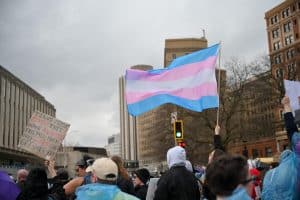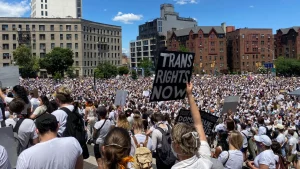This year marks the fiftieth anniversary of the Stonewall uprising. Corporations used the opportunity for intense pinkwashing: rainbow sneakers, coffee mugs, and T-shirts. During Pride Month in New York City, the police marched in the official Pride parade alongside Bank of America, Wells Fargo, and other megacorporations. That same month, Layleen Polanco died in solitary confinement at Rikers Island. Perhaps nothing better demonstrates the contradictions in the LGBTQ+ movement today: Police were decked out in rainbows while a trans woman of color died in their custody.
No other group has gone from such marginalization to capitalist assimilation so quickly. In just fifty years, the cops went from beating, raping, and arresting us to marching in our parade. Since its inception, the LGBTQ+ movement has been divided on the question of assimilation: Do we want to fit into the current system, or do we want to change the whole thing? Here, revolutionary socialists can make an important contribution, with a strategy to beat capitalism and to fight all forms of oppression.
Assimilation and the Homophile Movement
Assimilationist organizations can be characterized as “single issue”—defining LGBTQ+ issues in the most narrow terms, which has often meant excluding trans people, people of color, and working-class people. These groups opt for tactics like lobbying and seek to tame the most sexually disruptive aspects of queerness—after all, they don’t want to scare away Democratic Party politicians and big donors. The underlying ideology is that the United States may be imperfect, but existing structures like the courts and Congress provide the means to perfect it. Justice is like a ladder; we can accumulate rights the same way we can climb the rungs, eventually reaching equality.
Sometimes the history of the modern queer movement is portrayed as starting at Stonewall, tracing its roots only to a radical past. This is a misreading of LGBTQ+ history; some gay activism was deeply assimilationist from the beginning. Among the first groups in the United States was the Mattachine Society, founded in 1950. They used the term “homophile movement” to avoid mentioning sex. Mattachine was not the only group of this kind, however. Most notably, Daughters of Bilitis began organizing lesbians a few years after the creation of the Mattachine Society.
The homophile organizations emerged in a terrible, repressive context: in 1953, President Eisenhower issued an executive order establishing “sexual perversion” as a fireable offense from a government job, and hundreds were fired in what became known as the Lavender Scare. All but one state explicitly outlawed homosexual sex. There were regular raids of bars in which, police beat and arrested LGBTQ+ people, sometimes publishing their names in local newspapers. The early LGBTQ+ organizing of the 1950s also came about in the context of the Red Scare, in which homosexuality and communism were often conflated: the idea was that “sexual perverts” were weak-willed and easily corruptible, and that they could give in to the “communist threat.”
The Mattachine Society was started in the 1950s by former Communist Party members with the goal of providing gay people with a sense of belonging, and to “develop a homosexual ethic. Disciplined, moral and socially responsible.”1Van Grosse, The Movement of the New Left 1950-1975 (New York: St. Martin’s Press, 2005), 40. In the repressive environment of the 1950s and early 1960s, the Mattachine Society was a lifeline for many gay men, and even a few lesbians, reaching thousands across the country with their publication, the Mattachine Review.
As Nan Amalia Boyd explains in Wide Open Town, Mattachine tried to portray its members as good and proper American citizens; the group’s leaders “attempted to distance their constituencies from practices that conflated gender transgression with homosexuality. They also distanced themselves from activism and political contestations of communities of color.”2Nan Amalia Boyd, Wide Open Town (Berkeley: University of California Press, 2003), 179. They fostered faith in the American Dream, with a letter published in the Mattachine Review that said, “Our hearts are not less full of pride and honor at the sight of massed American flags because we are homosexual.”3“An Open Letter to Senator Dirksen,” Mattachine Review, no. 1 (January/February 1955).
Mattachine made a notable right turn starting in 1953, when one wing of the group attempted to position itself as actively anti-Communist, even though several of its founders were former Communist Party members. Ultimately, the internal struggle led three of the five founders, including the group’s leader, Harry Hay, to resign. By 1956, the Mattachine Society claimed it was “unalterably opposed to Communists and Communist activity and [would] not tolerate the use of its name organization by or for any Communist group or front.”4“Aims and Principles,” Mattachine Review, no. 2, special issue (January 1956).
And while the Mattachine Society was anti-Communist, the Communist Party of the United States, following the dictates of the Communist International, was anti-LGBTQ+. In 1918, the Bolsheviks decriminalized “homosexuality,” but Stalin recriminalized it in 1933. This was a tremendous betrayal of the emancipatory ideas of the October Revolution, a betrayal that was carried out by the Communist parties all over the world. The Communist Party’s homo- and transphobic policies were why Hay’s Mattachine Society did not connect the socialist organizing that Hay had once been involved in to the gay activism he later built.
Stonewall and the Radical Queers
“Like a dam bursting, Stonewall was the eruption after 20 years of trickling progress by small handfuls of men and women whose conscious organizing gave way to a spontaneous wave of fury,” Sherry Wolf writes in Sexuality and Socialism.5Sherry Wolf, Sexuality and Socialism (Chicago: Haymarket Books, 2009). Stonewall was part of a radical era marked by the Black Power, anti-war, and feminist movements. Stonewall came one year after the global explosion of 1968—the French May, the Mexican student movement, the Tet Offensive, and the mass struggles against the Stalinist bureaucracy.
Stonewall was not the only uprising of this kind. In 1959, there was a riot at Cooper Do-nuts in L.A., and in 1966, there was the Compton Cafeteria Riot in San Francisco. But what was new about Stonewall was the kind of organizing that occurred afterward.
Stonewall was everything that the Mattachine Society was not: it was angry, it was of color and trans, it was deviant, and it was a riot. Stonewall veteran Jim Fouratt said, “We were a nightmare to them [the homophile movement]. They were committed to being nice, acceptable status quo Americans and we were not; we had no interest at all in being acceptable.”6Martin Duberman, Stonewall (New York: Plume, 1994), 229. In fact, the Mattachine Society’s reaction after the first night of the Stonewall riots was to write a text calling for calm and quiet outside the Stonewall Inn.
The Gay Liberation Front was the most important group to emerge from the Stonewall uprising. The GLF newspaper, The Rat, encapsulated the spirit of the movement: “We are a revolutionary homosexual group of men and women formed with the realization that complete sexual liberation for all people cannot come about unless existing social institutions are abolished. We reject society’s attempt to impose sexual roles and definitions of our nature.”7Wolf, Sexuality and Socialism, 129. But there was no consensus on what exactly revolution meant. As Alan Sears argues in Queer Anti-capitalism, the new movement emphasized visibility, militancy, and the fight against normative sexual and gender roles. Sears proposes that this was an era of “sexual utopianism,” “which cast the erotic as a realm for liberation” and for which the enemy was normativity.8Alan Sears, “Queer Anti-capitalism: What’s Left of Lesbian and Gay Liberation?,” Science & Society, vol. 69, no. 1 (January 2005), 91-112.
While the political focus of the new queer movement was an “in your face” sexuality, elements of this movement were also intersectional and anti-imperialist. The name itself, the Gay Liberation Front, referred to the National Liberation Front of Vietnam, a clear nod toward anti-imperialism. The GLF declared, “We identify ourselves with all the oppressed: The Vietnamese struggle, the third world, the blacks, the workers … all those oppressed by this rotten, dirty, vile, fucked up capitalist conspiracy.”9Wolf, Sexuality and Socialism, 129. Likewise, the GLF sought a relationship with the Black Panther Party in particular, meeting with Panther leaders and attending their 1970 conference. The organized working class, however, was mostly absent from the GLF’s reflections.
For the GLF, fighting assimilation meant fighting a politics of representation in the upper echelons of capital. Come Out newspaper wrote, “We will not be gay bourgeoisie, searching for the sterile ‘American dream’ of the ivy-covered cottage and the good corporation job, but neither will we tolerate the exclusion of homosexuals from any area of American life.”10“Editorial 1.” Come Out! Selections from the Radial Gay Liberation Newspaper (New York: Times Change Press, 1970). Some were even anti-capitalist. A former member of the Chicago GLF said that the movement “had a political view that world capitalism dominated by the U.S. military industrial complex was not something to reform or ameliorate, but rather to destroy and replace with a system of equality and justice.”11Fred Eggan, “Dykes and Fags Want Everything: Dreaming with the Gay Liberation Front” in That’s Revolting! Queer Strategies for Resisting Assimilation (Berkley: Publishers Group Press: 2004).
But the GLF was short lived. Its meetings, open to all and run by consensus, were unmanageable—being queer did not mean the attendees could reach political agreement. If the goal was revolution, what did that mean? And who was the enemy? Was it men, as some feminists were beginning to say? Or was it straight people, as some radical queers began to say? Was it the capitalist state? The GLF split into groups that took various positions on these questions, such as the Radicalesbians, Street Transvestites Action Revolutionaries (STAR), and the Gay Activist Alliance.
Despite these groups’ revolutionary rhetoric, the capitalist state was notably absent from many of their political reflections, and the “revolution” was conceived as a primarily cultural one. “Gay power” or lesbian separatism were seen as viable strategies. For many, the enemy became “straight values” and “straight society”—separate from the capitalists and the state that organized society around hetero and cis normativity in the first place.
Like Stalinism at the birth of the homophile movement, Fidel Castro played a similar role of distancing socialism from the new queer movement. In 1965, Castro put LGBTQ+ people in concentration camps known as Military Units to Increase Production. In the United States, much of the Left offered unconditional support to Castro’s government, either agreeing that “homosexuality” was bourgeois (as the Communist Party and the solidarity brigades did) or arguing that fighting for LGBTQ+ rights in Cuba amounted to “cultural imperialism.” Indeed, U.S. revolutionaries should defend the Cuban Revolution from U.S. imperialist attacks. But that defense did not imply support for an undemocratic bureaucracy that put LGBTQ+ people in concentration camps.
The Nonprofitization of the LGBTQ+ Movement
Just when it seemed that radical queer organizing was beginning to die down, the AIDS crisis began. As the government refused to acknowledge the crisis, AIDS decimated the queer community while the religious right portrayed it as a gay disease that had come to wipe out homosexual sinners. In this context, radical queer organizing reemerged at the birth of the neoliberal era. In the late 1980s, ACT UP focused on direct action against the government’s inaction on AIDS and the corporate greed that allowed companies to profit from the crisis.
Since then, the queer movement has “managed to advance when all around were in retreat.”12Elizabeth Wilson, “Is Transgression Transgressive?” in Activating Theory, ed. J. Bristow and A.R. Wilson (London: Lawrence and Wishart, 1993): 107-117. As neoliberalism marched forward, the activism of LGBTQ+ people, the ideology of formal equality under capital, and the promise of pinkwashing profits meant that some of the most discriminatory laws against gay and lesbian people were rescinded—like the ban on “sodomy,” which was lifted federally only in 2003. LGBTQ+ people won the right to marry across the United States in 2015. Today, an openly gay man is a serious contender to be the presidential candidate of the Democratic Party. Capitalism has proved itself flexible enough to integrate some gay and lesbian people into the upper echelons of power and to commodify gay and lesbian sexuality, while marginalizing working-class queers and queers of color. Indeed, LGBTQ+ people are not a monolithic group, and as some of us gain more rights, the more the race and class differences among us become evident.
Two significant things have occurred in the past three decades: government services have been slashed, and gay and lesbian identities have been, to some degree, normalized. As a result, the LGBT+ movement has become almost entirely driven into the nonprofit industrial complex. This was part of a generalized boom in nonprofits, from three thousand in 1965 to 1.5 million today. The nonprofit industrial complex is the very narrow stage for the assimilation debate today. Particularly, the nonprofit called the Human Rights Campaign carries on the legacy of the homophile movement. Other nonprofits attempt to carry on the legacy of Stonewall, although even the most radical are under constant conservative pressure.
The Human Rights Campaign
The Human Rights Campaign (HRC) organizes in significantly less adverse conditions and with significantly more resources than the Mattachine Society could ever have dreamt of: it has an annual income of over $45 million and corporate sponsors like Citibank and Apple. Nonetheless, the goal of the Human Rights Campaign is strikingly similar to that of the old homophile movement: assimilation into the capitalist and patriarchal system.
Like the Mattachine Society, the HRC focuses on the most narrow issues. For them, this means fighting for same-sex marriage and against the ban on LGBTQ+ people in the military. Trans people are consistently left out of the equation, as in the HRC’s support for a version of the Employment Non-Discrimination Act that does not include trans people. The HRC attempts to show that gay and lesbian people are respectable, patriotic Americans. The HRC campaigns for Democrats and cozies up to the country’s most vile capitalists. In 2017, the group even gave Jeff Bezos an “Equality Award,” while Amazon workers labor in inhumane conditions for minimal wages.
Unlike capitalists during the era of the homophile movement, a whole sector of the country’s capitalists now actually wants to attend gay galas. And unlike the leaders of the homophile movement who poured money from their own pockets into their organizing, the CEO of the HRC makes about half a million dollars a year. The HRC, with all its power and resources, controls the agenda of the mainstream LGBTQ+ movement, constraining it to a narrow set of demands to be achieved by campaigning for the Democratic Party.
Queer Liberation Nonprofits
The HRC is not the only kind of LGBTQ+ oriented nonprofit. Some others embrace a politics that is much more intersectional and radical: groups like the Sylvia Rivera Law Project, the Audre Lorde Project, and Queers for Economic Justice. Some authors have called these groups queer liberation organizations. They are the neoliberal manifestation of the dreams of Stonewall. Like the Stonewall-era organizations, they lack a cohesive strategy for liberation, and on top of that, they are stuck in a rat race for funding.
To their credit, these organizations offer an expansive view of queer liberation that includes discussions of the prison industrial complex, the immigration system, and the neoliberal rollback of government services. Some, like the Stonewall-era organizations, incorporate a critique of capitalism. They are for what Dean Spade has called “trickle up social justice”: the idea that organizations should first tackle the issues that affect the most marginalized, which would also benefit all the strata above them.
And although these nonprofits encourage people to imagine a liberated future, in terms of strategy, they don’t offer much more than a plan for reforms. Like the members of the GLF, the progressive queers who work at these nonprofits don’t agree on their goals or on their strategy to achieve them. Is the goal cultural change? To expand government services? Given the lack of clear political agreement, the conservative pressures put on nonprofits are even harder to withstand.
Many of these nonprofits provide important and much-needed services for the queer community. Yet, as Myrl Beam argues in Gay Inc., the real need to get funding to provide these services is a material, conservative pressure. Logan, a nonprofit worker, says that “when the mission is to subvert the very institutions that made it possible to get the grant, it has to be hard, because you’re using a tool that is designed to maintain a structure you are trying to dismantle.”13Myrl Beam, Gay Inc: The Non-Profitization of Queer Politics (Minneapolis: University of Minnesota Press, 2018). Many people who work at nonprofits know this: despite the most left-wing intentions, nonprofits could keep providing services forever without ending capitalism and without actually creating a society free of exploitation and oppression. This is the problem with queer liberation nonprofits: they will never deliver queer liberation.
We cannot have queer liberation in a society based on the exploitation of the many for the profits of a few. This is why our rights are not a ladder, why our rights cannot accumulate toward liberation, and why intersectional exploitation and rainbow CEO’s cannot liberate us—because for the majority of queers, who belong to the working class, many of whom are of color, a gay president won’t change the fact that we struggle to make a living. It is also why our sexuality in itself is not the site for liberation, as the appropriation and commodification of queer sexuality makes clear. But intersectionality and fighting for reforms and services for those on the bottom are insufficient for queer liberation. A critique of capitalism is not enough to free us from it.
Queer liberation is only possible in a society built for people, not profit—a society in which all our material needs are fulfilled, and further, a society that provides free time and liberates our creative potential: in communism.
The Fight for Socialist Revolution
Our oppression and exploitation cannot be ended by changing only the culture. Our oppression is rooted in the institutions of the capitalist state: the prisons, the cops, the schools, as well as in the role of Christianity in the state. It is rooted in the gender roles that are necessary to extract unpaid reproductive labor primarily from women, as well as in the general alienation inside and outside the workplace. It is rooted in a society of sexual misery,in which we wear down our bodies and minds on the job so that we are only a shadow of ourselves when we come home. We cannot reform our way out of this: we need a revolution that expropriates the capitalists, creating the material basis for massive cultural changes to liberate our gender, sexuality, and all of humanity. This is the goal of communism.
Although the capitalist state seems invincible, the working class is strong: we produce everything, and we make all of capitalism run. That is why the working class is the muscle behind a revolution: the one that can bring the entire system to its knees, then get things running again under collective, democratic control. The working class today represents the majority of the world population, made up of people of color, people with disabilities, queer folks, women, and, yes, white cis guys too.
But the working class “for itself” is not enough. To lead a revolution, the working class has to show that it—not capitalist tokens like Pete Buttigieg—can resolve all of society’s problems, including the oppression of LGBTQ+ people. This alliance between the working class and all oppressed groups is the necessary basis for a socialist revolution.
Luckily, we are in a political moment when increasing numbers of young people are socialists or socialist-curious—who know that this system holds nothing but misery for us. But if our goal is socialism—a socialism that is far different from Stalin’s or Castro’s homo and transphobic bureaucracy—who or what examples can we turn to?
There is a socialist history that runs counter to the brutally homophobic legacy of Stalinism. As far back as 1895, the Communists were the only group to defend Oscar Wilde and to defend the legalization of homosexuality. In the Soviet Union, the Bolsheviks did so in 1919. But, as the USSR became increasingly bureaucratized, it rolled back more and more of the victories of the Russian Revolution, including those around gender and sexuality. At this time, Leon Trotsky and the Left Opposition put up a fight against it. As a result, any opposition to Stalinism became known as “Trotskyist,” and the Left Opposition was killed by Stalinists around the world. Trotsky himself was killed in 1940.
Trotskyism is a continuation of the thread of the liberatory ideas of Marx and the Bolshevik revolution, and it offers a theory and a strategy to crush capitalism and build a society without oppression. This does not mean that all organizations that have taken up the mantle of Trotskyism have had the correct politics toward oppressed groups, but that a Trotskyist framework can organize a theory and strategy for liberation.
Trotsky emphasized the importance of organizing the most oppressed. In the Transitional Program, he said, “Opportunist organizations by their very nature concentrate their chief attention on the top layers of the working class and therefore ignore both the youth and the women workers. The decay of capitalism, however, deals its heaviest blows to the woman as a wage earner and as a housewife. The sections of the Fourth International should seek bases of support among the most exploited layers of the working class; consequently, among the women workers.” If one only seeks reforms, or to negotiate with capitalists for crumbs, then it is of course the most oppressed who are inevitably sold out, and it is inevitably internationalism that is sold out. This is what assimilationist and reformist politics delivers.
A Communist Future
No one can say exactly what communism will look like. What we can say is that it will be a society that ends exploitation, borders, and prisons—a society in which Layleen Polanco would be alive and thriving. In communism we would eliminate the exploitation of labor and alienation at the workplace, giving us immense amounts of free time. Herbert Marcuse envisioned this future in Eros and Civilization: “The quantum of instinctual energy still to be diverted into necessary labor (in turn completely mechanized and rationalized) would be so small that a large area of repressive constraints and modifications, no longer sustained by external forces would collapse. … Eros, the life instincts would be released to an unprecedented degree.”
Similarly, under communism, domestic work will be socialized, so that parenting, cooking, and all reproductive labor will be taken up by the community, and when taken up individually, they will be a labor of love, not of necessity. As the Bolsheviks and other early Marxists envisioned, it will mean the end of the (heteropatriarchal) family as a building block of society. In communism, the material basis for gender roles will disappear, and what will come afterward no one can really know.
As Marx argues in The German Ideology, the promise of communism makes it possible “to do one thing today and another tomorrow, to hunt in the morning, fish in the afternoon, rear cattle in the evening, criticise after dinner, just as I have a mind, without ever becoming hunter, fisherman, herdsman or critic.”15 Perhaps this can apply to gender and sexuality as well: communism will give us the freedom to live our gender and sexuality with as much freedom and fluidity as we want.
Notes
| ↑1 | Van Grosse, The Movement of the New Left 1950-1975 (New York: St. Martin’s Press, 2005), 40. |
|---|---|
| ↑2 | Nan Amalia Boyd, Wide Open Town (Berkeley: University of California Press, 2003), 179. |
| ↑3 | “An Open Letter to Senator Dirksen,” Mattachine Review, no. 1 (January/February 1955). |
| ↑4 | “Aims and Principles,” Mattachine Review, no. 2, special issue (January 1956). |
| ↑5 | Sherry Wolf, Sexuality and Socialism (Chicago: Haymarket Books, 2009). |
| ↑6 | Martin Duberman, Stonewall (New York: Plume, 1994), 229. |
| ↑7 | Wolf, Sexuality and Socialism, 129. |
| ↑8 | Alan Sears, “Queer Anti-capitalism: What’s Left of Lesbian and Gay Liberation?,” Science & Society, vol. 69, no. 1 (January 2005), 91-112. |
| ↑9 | Wolf, Sexuality and Socialism, 129. |
| ↑10 | “Editorial 1.” Come Out! Selections from the Radial Gay Liberation Newspaper (New York: Times Change Press, 1970). |
| ↑11 | Fred Eggan, “Dykes and Fags Want Everything: Dreaming with the Gay Liberation Front” in That’s Revolting! Queer Strategies for Resisting Assimilation (Berkley: Publishers Group Press: 2004). |
| ↑12 | Elizabeth Wilson, “Is Transgression Transgressive?” in Activating Theory, ed. J. Bristow and A.R. Wilson (London: Lawrence and Wishart, 1993): 107-117. |
| ↑13 | Myrl Beam, Gay Inc: The Non-Profitization of Queer Politics (Minneapolis: University of Minnesota Press, 2018). |











